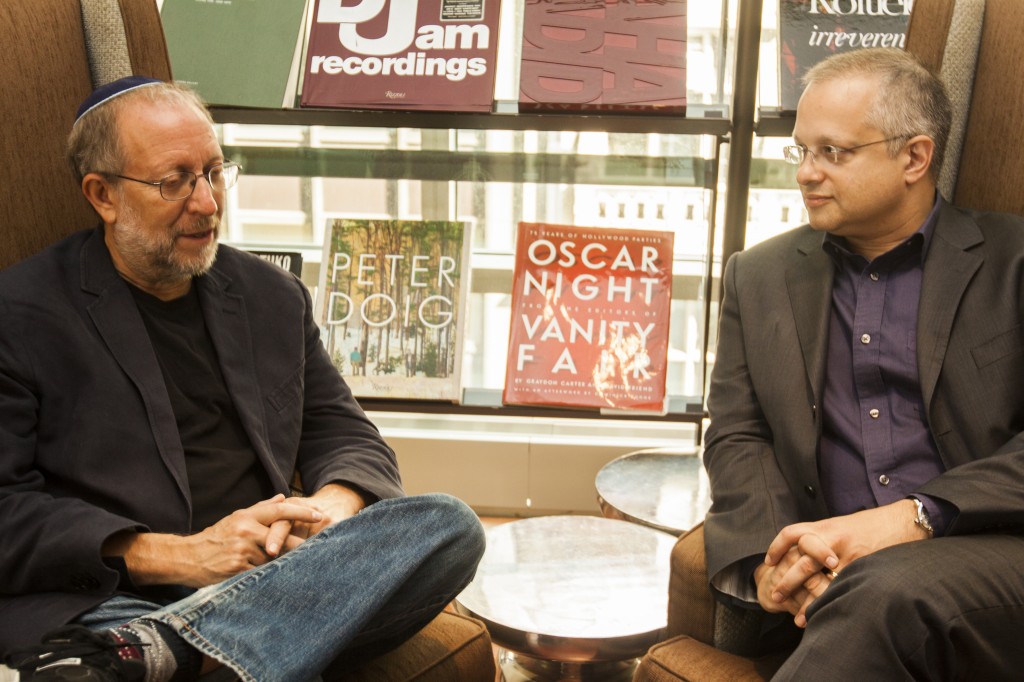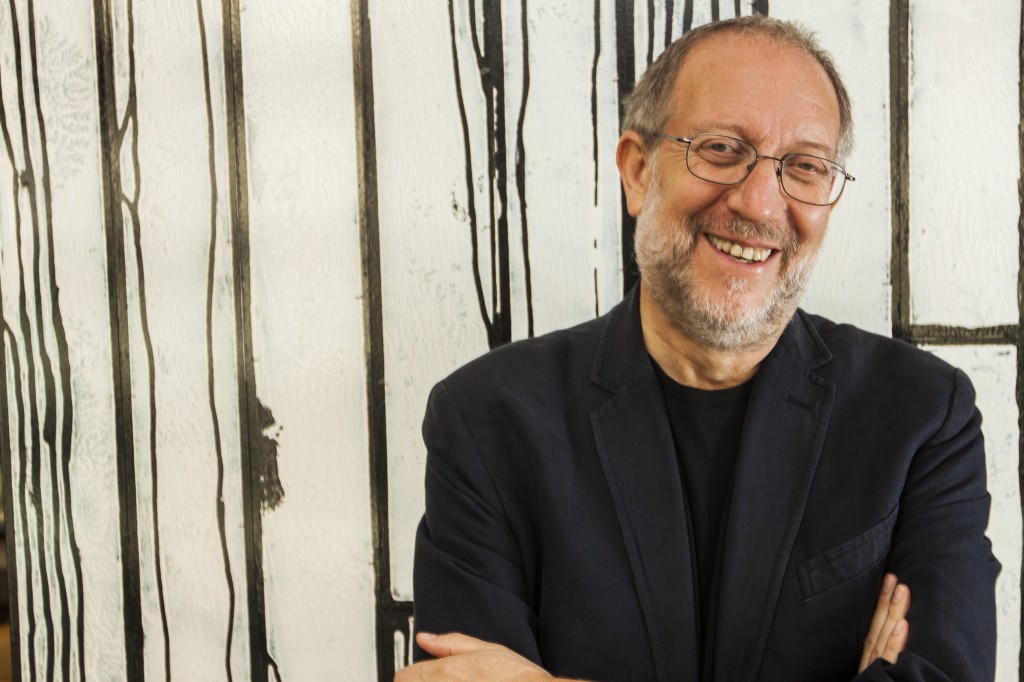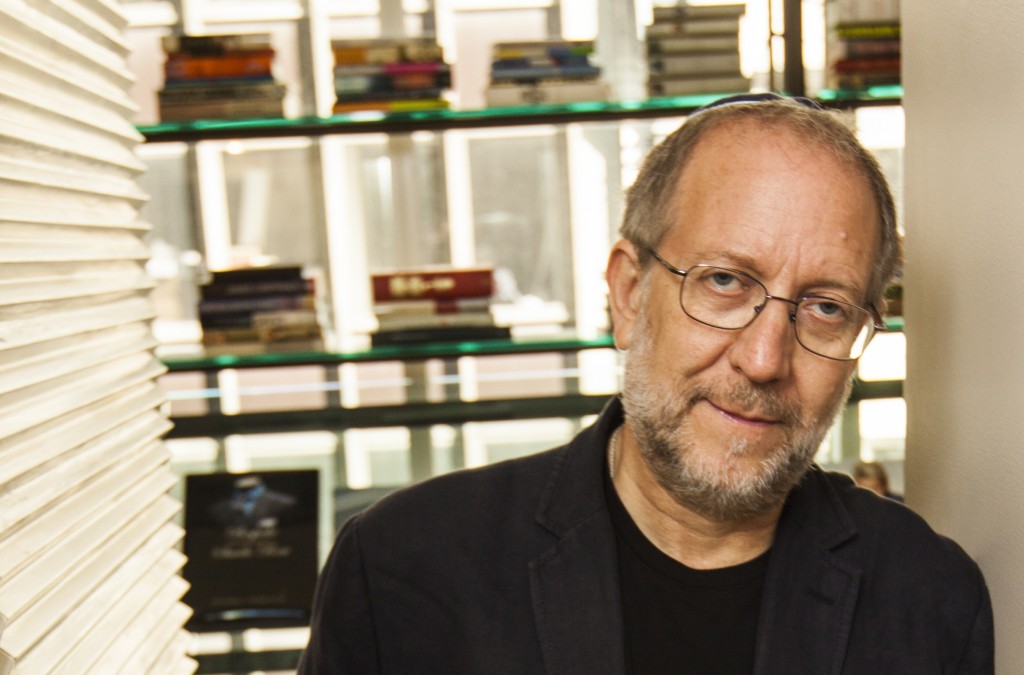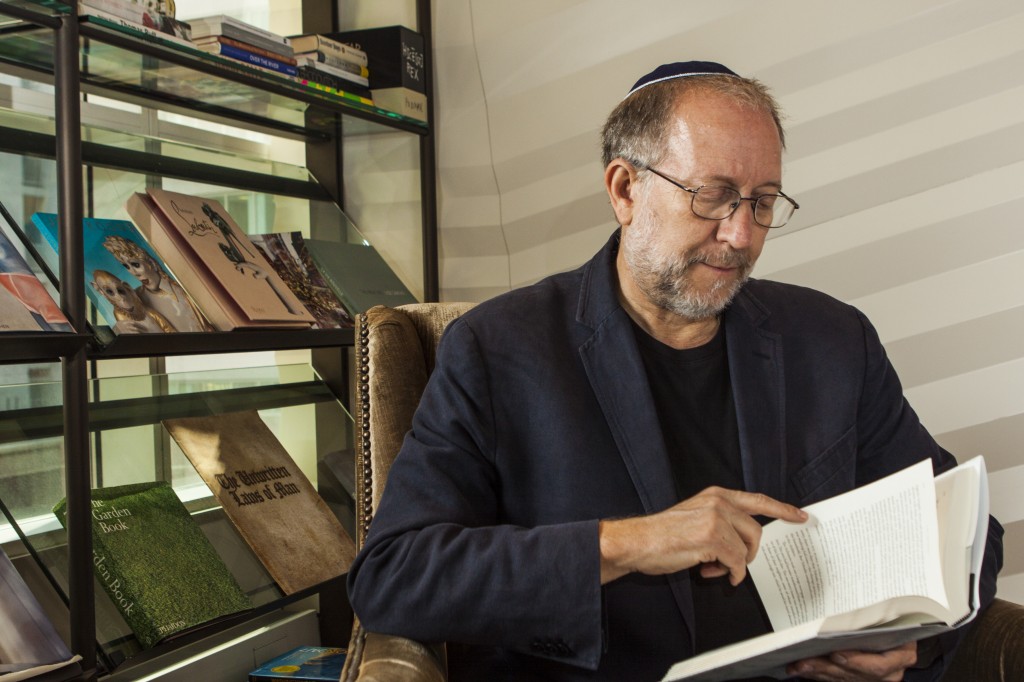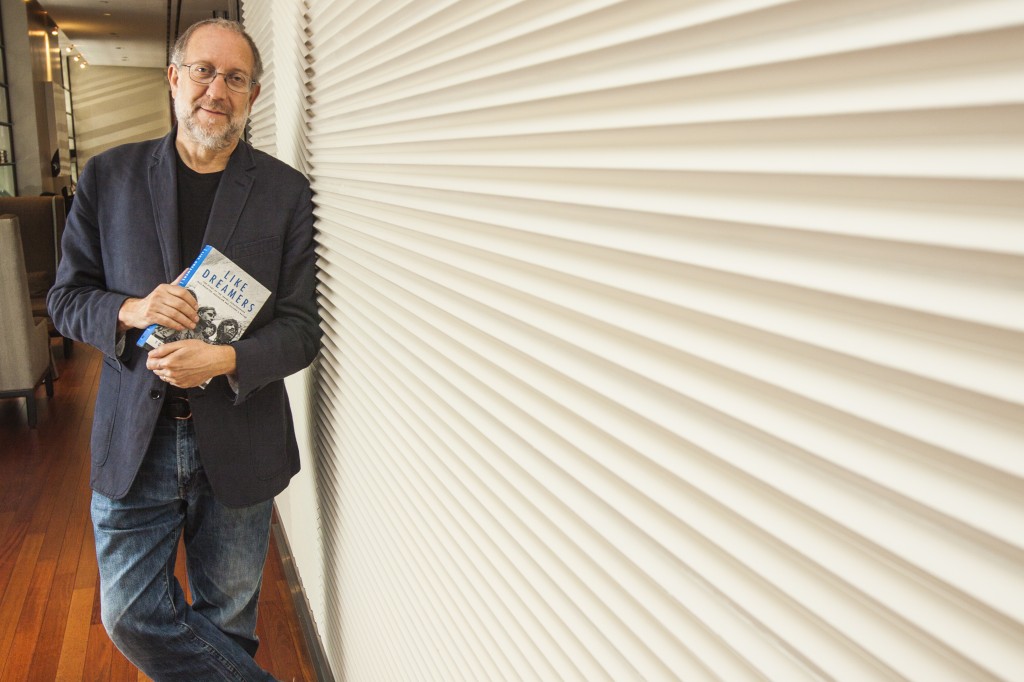After growing up in Brooklyn in the shadow of the Holocaust, Yossi Klein Halevi’s life changed in the summer of 1967. His riveting, majestic new book explores the anger, the love, and powerful dreams of the last generation as seen through the eyes of the IDF paratroopers who shaped its history.
“I really wasn’t trying to make the settlers look crazy in my book. Not them, nor the kibbutzniks,” says Yossi Klein Halevi. “My goal was to try and understand the emotional, spiritual, ideological contexts that both of these movements emerged in.”
He speaks carefully, deliberately as he looks at the menu. “What they have in common, despite their obvious political differences, is that they both grew out of the utopian, messianic impulse that was always a crucial part of Zionism. That world wasn’t the one I grew up in. So to write the book, I really had to learn their thinking for the first time.”
American-born and raised, Klein Halevi has long been one of the most eloquent advocates for a pragmatic, centrist form of Zionism, one that emphasizes both the hazards of occupation and the extreme difficulty of achieving peace. For years, in writing and speeches, he has signified a rare mix of toughness and compassion, a muscular Zionism that can engage with the Palestinians with respect, coupled with a spiritual, tradition-facing Judaism that can engage with post-modernity and other faiths.
Now he has written an immense work of Israeli historiography, focusing on the two conflicting utopian visions that drove the political and cultural debate in the last generation. It’s a new look, one that tries to wrap the stories of the settlers and the kibbutzniks into a single coherent Israeli narrative—a new Israeli story. And he has done it at a time when the world is struggling to understand an Israel that looks and acts far more like a normal, non-Utopian country than ever before.
Like Dreamers: The Story of the Israeli Paratroopers who Reunited Jerusalem and Divided a Nation (Harper, 2013) is a sweeping work, an “Israeli epic,” according to former Israeli ambassador to Washington, Michael B. Oren. At over 500 pages, it traces the lives of the soldiers who participated in the battle for Jerusalem in the 1967 Six Day War, and uses them as a kind of stand-in for the history of Israel as a whole. It is a rich and complex narrative covering some of the most pivotal years of Israel’s history, through the eyes of people who were at its front lines. And it reads like a novel.
I’ve known Yossi since we worked at the same research institute in Jerusalem a decade ago. I caught up with him in a Manhattan club this past month. We took some time for a photo shoot for this essay, and then sat down to talk over lunch.
I point out that he’s lost weight since I last saw him, and he tells me about his fish-intensive diet and his yoga. Despite his Orthodox upbringing, he’s never been afraid of eastern or other non-Jewish wisdoms, though always on his own, very Jewish terms. Indeed, for all his eagerness to understand others, his eyes testify to a scarcely-veiled, ancient and possessive biblical rage, and a fiery human compassion that flows, somehow, out of it. He speaks intensely and carefully on every subject, even when laughing, and he retains more than a trace of a refined, tactful, old Jewish Brooklyn—as much in his scruffy, battle-worn look as in his warm accent.
“I grew up in Beitar in the 1960s,” he tells me—and I am struck by how, for so many of us American-born Jews, engagement with Israel in adulthood continues to be shaped by the specific movements of our youth. Beitar was the secular, right-wing Zionist movement founded by Vladimir Jabotinsky in Latvia in the 1920s, and epitomized by the nationalist militant groups Etzel and Lehi in the 1940s, and by Likud leaders like Menachem Begin and Yitzhak Shamir. Before the Likud’s rise to power in 1977, these groups had always been on the outside of Zionism looking in, failing to compete with the leadership of David Ben-Gurion, Chaim Weizmann, and the Mapai party. But this take on Beitar is one I’ve never heard:
In Beitar, we were the big losers in the Zionist story. And we weren’t gracious losers. As we saw it, we were the ones who drove the British out of Palestine. We were the ones who knew the Holocaust was coming and tried to warn everybody. We were the ones who should have founded the state. Zionism, as we saw it, was supposed to rescue the Jews from Europe. It failed. We had always dreamed of “Two Banks of the Jordan River,” of the big map that included what is today the kingdom of Jordan. Those were the borders of rescue. That was supposed to be the State of Israel. But Zionism had failed the Jews of Europe. So we felt profound alienation from the Israel that was founded, and anger, even rage. The Israel that was created was the wrong Israel. It was supposed to be ours. That was my Zionism.
In 1966, at the age of 13, Yossi attended a Beitar summer camp in the Catskills village of Neversink, New York. His parents were traditional Orthodox Jews, and had no clue that their son was going to the mountains to learn to shoot a rifle and conduct field maneuvers. The songs they sang at that camp had lyrics like “In blood and fire Judea fell, in blood and fire Judea will be reborn.” Once a troupe of Israeli folk dancers came to visit the camp. Yossi’s counselor observed that they had arrived in a Volkswagen—which they called a “Nazi Wagon.” They all snuck down to the parking lot and rolled the car over, pushing it out of the campgrounds and into a ditch. “That German car had defiled our sacred space.”
Yet despite the passion and even violence, Beitar was not, he explains, messianic or utopian. This is a crucial distinction in his worldview, what he sees as possibly the most important division in Zionist history—not so much between Left and Right, as between what he calls normalizing and messianic. “Ever since the Bible, Judaism has always encompassed both of these forces: People who said ‘let’s make our nation be like other nations’ and those who said ‘let’s be different, a light unto nations.’”
Beitar’s beliefs were indeed uncompromising, but not out of a utopian dream. Instead they spoke of the extreme physical, existential dangers facing Jews around the world. Beitar spoke of rescue, of the restoration of the Jewish people to a normal, sovereign, self-defending existence. Ending the terror and shame of exile once and for all. Indeed, Jabotinsky was famous for having warned about the impending destruction of European Jewry. “Jabotinsky told everyone, you are sitting on a volcano. Give up your utopian delusions. It’s leading to disaster. And I understood that.”
For Yossi as a child, the world was filled with violent threats to Jewish survival. Considering that the Holocaust had ended just a few years before he was born, and that his father had spent the war in hiding in Europe, this made a lot of sense.
His life took a radical turn, however, in the summer of 1967. Just two weeks after the Six Day War, his father announced they were going to Israel for the summer. He spent time with relatives in Tiberias and Haifa. He went to the original kibbutz, Degania, and spent long days at the Sea of Galilee. He toured the Golan Heights and went to the sleepy Red Sea hamlet of Eilat and down into the Sinai. All the places that represented the “normalized” Israel of rescue. But he also went to the ancient city of Hebron, where the Jewish patriarchs were buried, and to Bethlehem. Symbols of transcendence.
The experience of encountering the real Israel—as opposed to the Israel of Beitar summer camp—was overwhelming, and it vitiated all the rage he had been taught to build in his youth movement. Israel was suddenly real, and the reality of Jews in their own homeland trumped all the ideological anger he had been fed. He was overwhelmed with a sense of love, and sensitive to the mutual responsibility he found underlying the Israeli experience.
Israel was an incredible example of what people could do when they loved and cared about each other. I was walking down a highway in the Galilee and people would stop and offer me a ride. That summer was 1967, and I remember getting my hands on a copy of Time Magazine, and they had this whole article on the Summer of Love happening right then in San Francisco. And I remember thinking, “It’s the Summer of Love here too. Jerusalem and San Francisco are the same.”
The most powerful experience on that trip, however, was the day that his father took him to the Western Wall. As they stood there, praying at the remains of the ancient Temple, finally able to do so as free and sovereign Jews for the first time since legend, Yossi saw his father undergo a transformation. “For my whole childhood, he’d had a very conflicted relationship with God. He was observant, but as a Holocaust survivor, he did battle with God every day. ‘Where were You? How could You allow it?’ My father lived in a permanent state of rage, even though he was a deeply loving man. But then we went to the Wall. And I saw him pray for real. For the first time. As we walked away, he said to me, ‘Now I can forgive God.’
“At that moment I found my belief, and claimed Judaism as my own.”
Two weeks before that, the Israel Defense Forces had, in just six days, routed the combined armies of the Arab world, in the process taking the Sinai Peninsula from Egypt, the Golan Heights from Syria, and the West Bank from Jordan. IDF paratroopers had conquered eastern Jerusalem from the Jordanians, reclaiming the site of the ancient Temple of Solomon, and announcing over the walkie-talkies that “the Temple Mount is in our hands.” Like Dreamers traces the lives of seven of these men.
They were not ordinary folks. In America when we think of soldiers at war, they are almost always anonymous men and women who, after heroic efforts, vanish back into anonymity. But Israel is a very small country. Each of the men portrayed in the book went on to hold prominent positions in Israeli politics, culture or society. Some of them, like Hanan Porat and Yoel Bin-Nun, became leaders of the national-religious revival and the settlement movement. Others, like Avital Geva and Arik Achmon, became important figures on the Left, artists and critics of the occupation. Meir Ariel became one of Israel’s most beloved songwriters.
Like a seasoned novelist—and in a stylistic departure from his previous memoirs and socio-political essays—Klein Halevi follows these men from their separate beginnings, interlacing their life stories, their mundane struggles and dreams, until that historic moment in early June 1967 when they all came together on the Temple Mount, metal touched rock, the armaments of the new secular state took hold of the most sacred place on earth, and man met God and stood his ground.
Here is the passage where Bin-Nun, in full battle gear, ascends the Temple Mount.
Yoel Bin-Nun approached the Lions’ Gate. Spread before him was the landscape of messianic dream. Terraced into the Mount of Olives were thousands of flat tombstones, of Jews who had chosen to be buried directly across from the Temple Mount, to be resurrected when the Messiah came. In the Valley of Kidron rose the conical stone monument called the Pillar of Absalom, after the rebellious son of King David, founder of the messianic line. Nearby, embedded in the Old City wall, was the Gate of Mercy, through which, according to tradition, the Messiah would enter, and which had been sealed by Muslims to thwart the redeemer of Israel. Yoel ran up the steep road leading to the Lions’ gate, past the still-smoking bus, and through the crowded gate.
When he reached the steps leading to the Dome of the Rock, he abruptly stopped: beyond lay the region of the Holy of Holies.
He felt lightheaded, as if on a mountain peak. To move from battle to this—
He couldn’t pray: prayer seemed inadequate. What was left to ask for? He felt himself to be an answered prayer to all those who had believed this day would come, that Jewish history would vindicate Jewish faith.
He studied the topography. “This was the women’s area of the Temple,” he told a friend. “How do you know, Yoel?” his friend asked, surprised. Yoel explained that he happened to be studying the laws of the Temple just before the war, and he could plainly see the Talmud’s description of the layout of the Mount.
Young men on their way up the stairs stopped to ask Yoel directions to the Western Wall. Yoel shrugged; the Wall didn’t interest him. The Jews had prayed there only because they’d been barred from the Mount. Why descend to the place of lamenting God’s absence from the place that celebrated His glory?
“So, Yoel, what do you say?” his kibbutznik officer asked.
“Two thousand years of exile are over,” replied Yoel.
The war gave Israel a double victory. On the one hand, it affirmed Israel’s normalizing reality—the Jews were able to defend themselves in their own land, it was hoped for the final time. At the same time, it affirmed its utopian pretentions, showing that a new era for mankind was possible. “For the Jews to go from Auschwitz to reconquering Jerusalem in just twenty years,” the author says to me, “what miracle could be greater than that?”
But like Israel itself, Like Dreamers doesn’t get lost in that miraculous moment. Instead it plows forward in time as it follows how the paratroopers dealt with the strange new reality brought by the war. Klein Halevi explains it against the backdrop of Zionism’s historical arc:
The genius of Zionism—and of its founder Theodor Herzl—had always been in its ability to fuse the two tendencies, the normalization and the messianic. To promise both. After thousands of years of exile and persecution, the very idea of normalization and sovereignty seemed utopian—all the more so after the Holocaust.
Until 1967 the tension between the transcendent and normalizing forces was contained. 1967, however, opens the abyss between normalization and transcendence. So in practical terms, these two messianic movements, settlements and kibbutzim, took opposite positions politically, but the irony is that they come from the same utopian sensibility, the belief that Israel has to be exemplary.
In 1967, Israel didn’t just take lands away from invading countries. While both the Golan Heights and the Sinai seemed, at the time, legitimate candidates to be traded back as bargaining chips in exchange for peace agreements—which, in the case of Egypt, happened a decade later—the West Bank and Eastern Jerusalem posed a unique problem. One side of Israel, the kibbutznik-driven, secular-utopian side had no need for the Old City and what Moshe Dayan once called “all that Vatican,” or of the military occupation of the Palestinians that they entailed. But another part of Zionism saw the return to ancient Judea and Samaria and Jerusalem as the clearest possible indicator that the ancient prophecies of the ingathering of exiles were being fulfilled before their eyes. Settlements became nothing less than the harbinger—even the enabler—of the Messiah.
Like Dreamers follows the subsequent breakup of the coherent Zionist narrative into competing forces: Left-Utopians vs. Right-Utopians, with normalizers rebutting both of them, pointing to the hazards of occupation and the bloodthirsty intentions of Israel’s enemies. The coherence of Zionism began, in Klein Halevi’s mind, to unravel. And yet, the stories of the paratroopers’ lives moved on.
“These men,” he says, “didn’t just fight together in the Six Day War. They continued to serve in the reserves afterwards. They met again on the battlefield in the Yom Kippur War in 1973, crossing the Suez Canal under Ariel Sharon.” The book takes us through that difficult war too (in which Israel was caught by surprise on the holiest day of the Jewish calendar, and was suddenly revealed to be neither secure nor a utopia), to the establishment of the ideological settlement movement Gush Emunim, to the nearly-revolutionary political moment of the first Likud election victory in 1977, to peace with Egypt, expansion of the settlements in the West Bank, the First Lebanon War in 1982, and beyond. Throughout the story, politics and culture are every bit as interwoven as they were for the men themselves. In the days following the 1967 war, Meir Ariel becomes famous for his song “Jerusalem of Iron,” an ironic rebuttal to Naomi Shemer’s anthem “Jerusalem of Gold.” Arik Achmon goes on to found Israel’s domestic aviation industry. Avital Geva gains a name as a conceptual artist and a founder of Peace Now, while Udi Adiv becomes a notorious anti-Zionist, later jailed for secretly visiting with terrorists in Syria.
“The most amazing thing about these men is that in between and after the wars, they didn’t disappear,” he says. “They preserved that same passion and vitality and channeled it into building the country. They fought with each other, over the vision to guide the country. They insisted on the utopian side of Israel, but disagreed about which kind of utopia.”
After his epiphanous teenage visit to Israel, Yossi Klein Halevi went back to Brooklyn and continued on his normalizing, Jabotinskyite path. He joined the Jewish Defense League, the activist group founded by Meir Kahane that taught Jews in New York City to take their physical protection into their own hands. Through the JDL he became active in the fledgling movement to free Soviet Jewry. Yet the experience of visiting Israel, of having his rage suddenly displaced by overpowering love, never left him, and made it difficult to maintain a Jewish identity built exclusively on anger about the Holocaust and the fear of annihilation.
The Soviet Jewry movement was, for me, a formative experience, because it was where love and rage converged. Anger could now be channeled into rescuing the last remnant of European Jewry. But I discovered something very different from Beitar there. The movement was much more about unifying the Jewish people. The founders saw it as a movement for the whole Jewish people—and even an interfaith movement, drawing the support of Martin Luther King and Roy Innis.
This radical contrast between Jewish defense and interfaith dialogue became a focus of his writing later on. Indeed, Yossi’s two previous books seem, at first, like memoirs written by two different people. The first, Memoirs of a Jewish Extremist, traces his experience in the JDL and his gradual break with that ultra-Right, and at times violent, group. The second, At the Entrance to the Garden of Eden, is about his travels with mystics of different religions, and his spiritual exploration through mystical Islam, Christianity and Judaism. But in the tale of his transformation from rage to love, each has its place.
With Like Dreamers, Klein Halevi has returned to 1967, which was as formative for him as it was for the State of Israel. The book, he tells me, serves two autobiographical purposes.
This is a book about how the Six Day War transformed Israel—which is my life. And it’s also a book about opposites, about transcendent and normalizing—and these are also different facets of my own self. My aim is to create, really for the first time, a pluralistic Israeli narrative, to take these opposite stories and to say, actually it’s the same story. Hanan Porat and Meir Ariel served in the same unit. Emil Grunzweig served with Yoel Bin-Nun. There aren’t two Israeli stories. Of course there’s a multiplicity of Israeli stories—but they’re all one story.
Like Dreamers is remarkable not just for its ability to capture, with sympathy and affection, the people who drove Israel’s two competing utopian visions in the most pivotal decade of its history—but also for what it doesn’t try to do. It’s not a comprehensive history, and makes no pretense of being all-inclusive. Most notably, the story has no Sephardic protagonists, even though the rise of Sephardic confidence, empowerment, and culture has been a crucial theme in Israel since the Likud electoral victory in 1977. Missing too are the stories of the immigrant communities, the Russians and the Ethiopians; or the rise of Tel Aviv as a creative, secular oasis. Or Israel’s Arab communities, for that matter. None of this, however, is problematic—on the contrary, the greatest strength of Like Dreamers is its narrative focus. Because these two movements, and the dreams they each offered, defined the Israeli psyche, and the Israeli political agenda, for decades.
But it’s important to note that we are speaking in the past tense—“defined.” Indeed, Like Dreamers brings home something that has been largely lost on American commentators about Israel: That both of these movements are basically spent. Though the demise of the kibbutzim has been widely discussed by those in the know, few people outside of Israel understand that a similar fate has befallen the dreamers of Gush Emunim, and that the Israel of today, even as it continues to allow settlement activity in the absence of a viable peace process, nonetheless has lost its taste for the messianic dreams that used to underlie it.
Once recent poll, for example, shows that 82 percent of Israelis point to settlement subsidies as the first thing that should be cut in order to balance the government budget. (“That includes a lot of Likud voters,” Yossi quips.) Instead of being seen as pioneers who are sacrificing for their people, settlers today have become vestigial of another time, or another interest group vying for a piece of the pie. Like the kibbutzim, the settlements continue to exist, but without that magnetic utopian spirit that used to bring Jews from around the world to the mountains of Judea by the thousands.
It is this dramatic turnabout—a collapse in spirit precipitated by a series of massive setbacks, including the Rabin assassination in 1995, Ariel Sharon’s evacuation of the Gaza Strip in 2005 and the public acceptance by Prime Minister Netanyahu in 2009 of the idea of a Palestinian state—that actually makes it possible to bring the settler narrative back into the conversation. “Most Israelis, even though they supported the disengagement from Gaza, nonetheless kept a soft spot in their hearts for the settlers who had been evacuated. Unlike liberal American Jews, who tend to see settlers unequivocally as the bad guys in the story, Israelis feel a sense of gratitude for the sacrifices they made. And it was important for me to restore them to the center of the narrative, almost as a kind of eulogy.”
Yet the book is also a eulogy for the kibbutz movement, whose fire has been dying a long and slow death for a generation or more. For Yossi perhaps the hardest lesson was to reconcile himself with his homegrown animosity to the hard Zionist Left, and to learn to love that movement as well, as a crucial part of the Zionist narrative and therefore of himself.
It was important for me to write a eulogy for the kibbutz. I fell in love with the kibbutz retroactively, the love I never felt when everybody else loved it in the 1960s. In the process, I’m going through the material, and having this experience, like that great line from the poem by Rachel—“Did you exist, or did I dream a dream?” Did it really happen? Did thousands of Jews from Argentina and Russia and New Jersey really come together to create the most egalitarian society that has ever existed, and probably ever will? This really shaped the modern Return to Zion, and just as Jews intuitively knew all along that it would be utopian, behold it was. That’s why I called the book Like Dreamers. Because it’s about the fate of our big dreams.
So, where is it all headed?
I press Yossi on the point. Having myself just come back to the U.S. after almost twenty years in Israel, I’m struck by how different the Israeli conversation feels now than it did when I first got there, during the heady days between the 1993 Oslo Accords and the 1995 Rabin assassination. Back when the great utopian movements still loomed large in the public psyche. When everyone knew that one transcendent dream would have to be given up to fulfill the other, and the only question was which would prevail. Today that feels like ancient history. Utopian visions have largely collapsed. As Klein Halevi has pointed out elsewhere, politically Israel has transformed from a polarized society where the peace camp and the dream of the Land of Israel competed not just for the imaginative heart but also for political power in the country. These camps no longer have their pull. Politically Israel has depolarized, unifying around a skeptical pragmatism that still wants peace but not at the cost of fanciful illusions. And it has also de-utopianized: Today it’s about the next Israeli app bought out by Google or the next TV show sold to HBO.
What, I ask Yossi, is the connection between the settlers and kibbutzniks who forged the country’s second generation, and the tech gurus and restaurateurs who seem to dominate its third? The swiftness of his answer belies the considerable thought he’s put into the question.
The word is vitality. Something incredible has happened in Israel. With the demise of the utopian movements, Israelis have indeed shifted their energies almost exclusively to normalization. But they haven’t grown dull. You’ve had an incredible transference of that original vitality to the next generation. There’s a myth out there, and a lot of Israelis say it, that they’ve abandoned the old spirit, that they’ve somehow become totally selfish. But it’s baloney.
Really? But isn’t the collapse of the utopian visions and the surge towards normalcy—isn’t that essentially giving up on the original founding spirit of Israel? Yossi is certain that it’s not. He looks to the social protest movement of two summers ago as clear evidence that the Israeli collectivist vitality is still very much there, even if it doesn’t express itself in ideologies pushing for a “light unto nations.”
Did you walk around the protest tents on Rothschild Street in Tel Aviv, David? It was incredible. Much more important socially and spiritually than economically. Economically it was very problematic. But socially and spiritually it was a thrilling moment. It was the summer of love. It was San Francisco. There were piles of used clothes people had put there for the taking. There was a booth where young lawyers offered free legal advice. There was a tent offering free psychological counseling. It really was Israel at its most beautiful. They were longing for the Israel that was, without realizing that it still is, and they are it. Just look how they re-created it in an instant, how immediately accessible it is for them. I remember there was this wonderful moment, one evening. They were getting angry, protesting, blocking traffic, and they spontaneously danced a hora. They started singing Yehoram Gaon’s song “I Haven’t Loved Enough,” which is really the ultimate classic Israeli song. You get it? They were going to shut down Tel Aviv because they were so angry—and what do they sing? “I haven’t loved enough.”
So the good news, for Klein Halevi, is that Israelis still have the transcendent vitality of the old movements, and that it gives them the tremendous creative energies necessary to be a Start-Up Nation—and also to pull together in times of crisis, despite all the “bourgeois decadence” that people like to say has come to surround them.
But there’s a danger here too. “What writing this book taught me was how deeply indebted today’s Israel is to the vitality of the dreamers. Yes, we need high-tech, but we also need the next generation of utopians. Hopefully Israelis will have the wisdom to separate those dreams from political or economic agendas. The last century taught the world that utopian visions really shouldn’t mix with politics, and need to be kept in the realm of culture and religion. But Israel won’t be able to survive for long without its dreamers.”
![]()
Banner Photo: Ilir Bajraktari / The Tower






